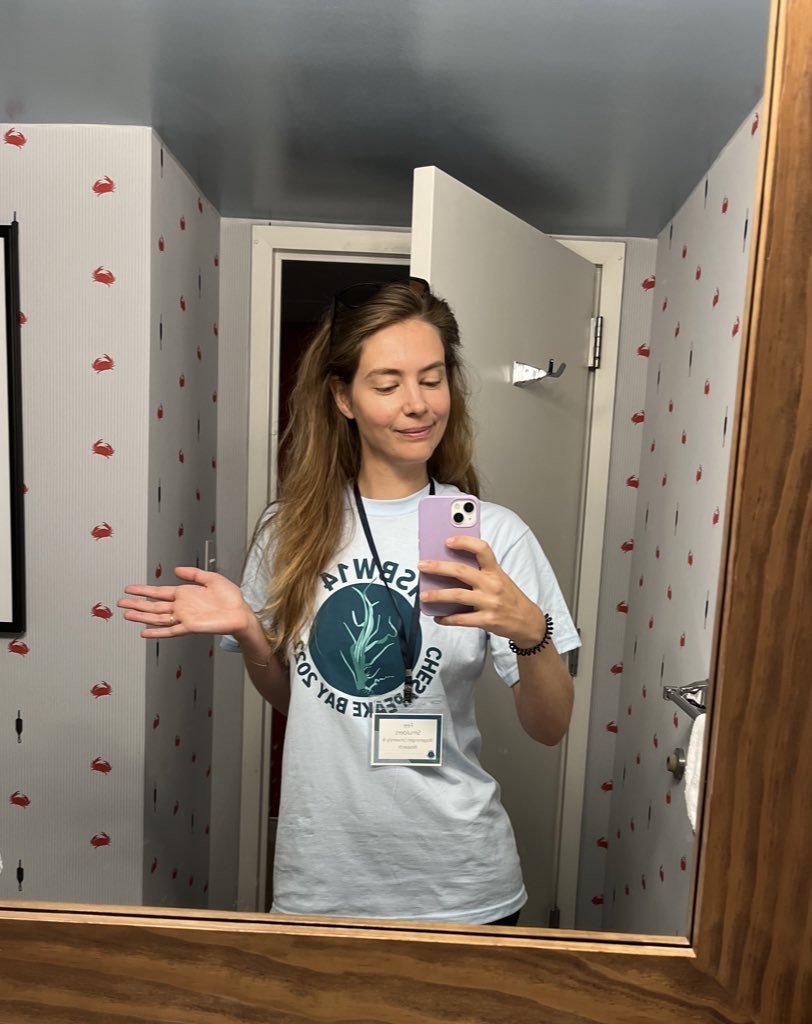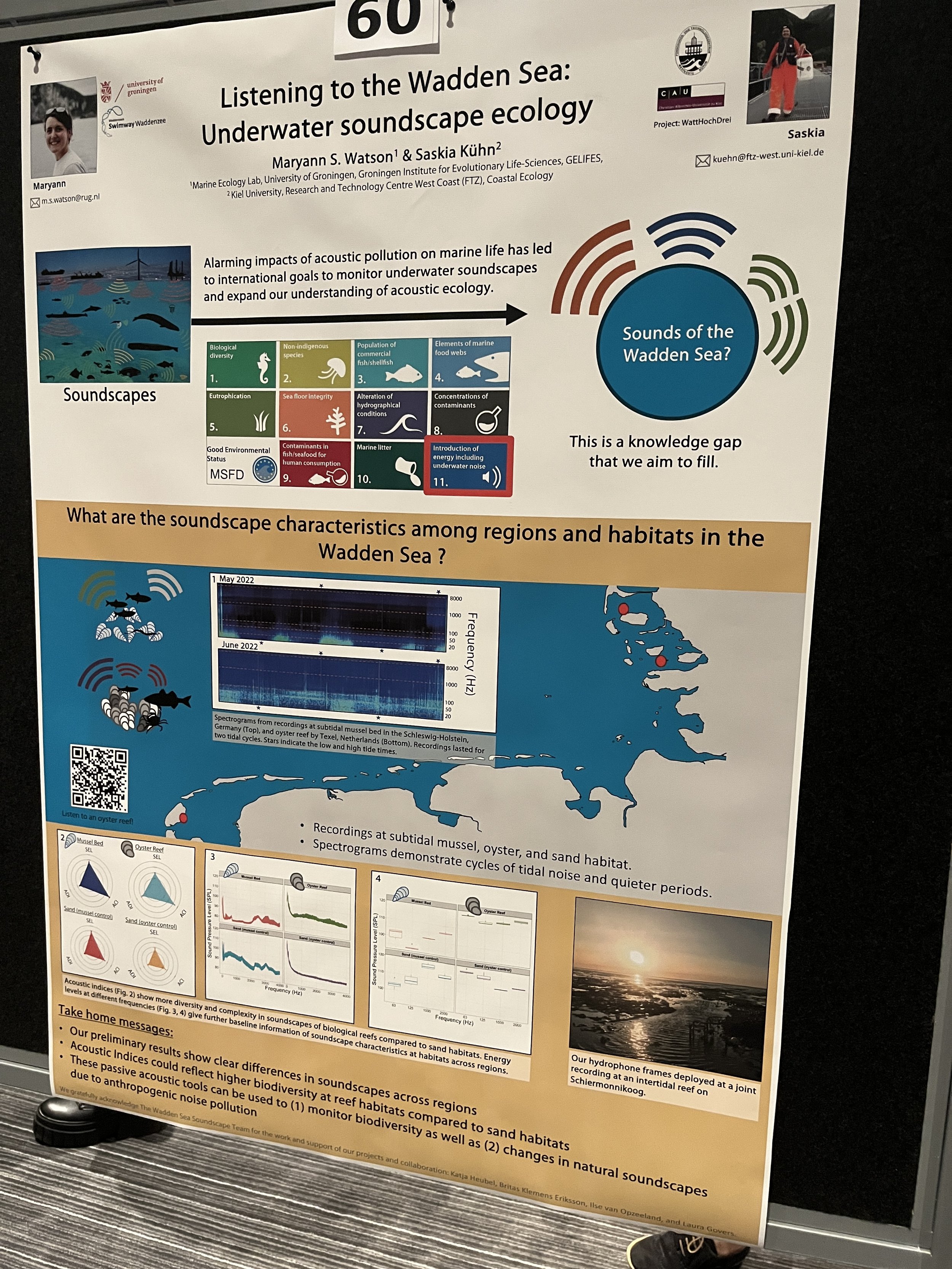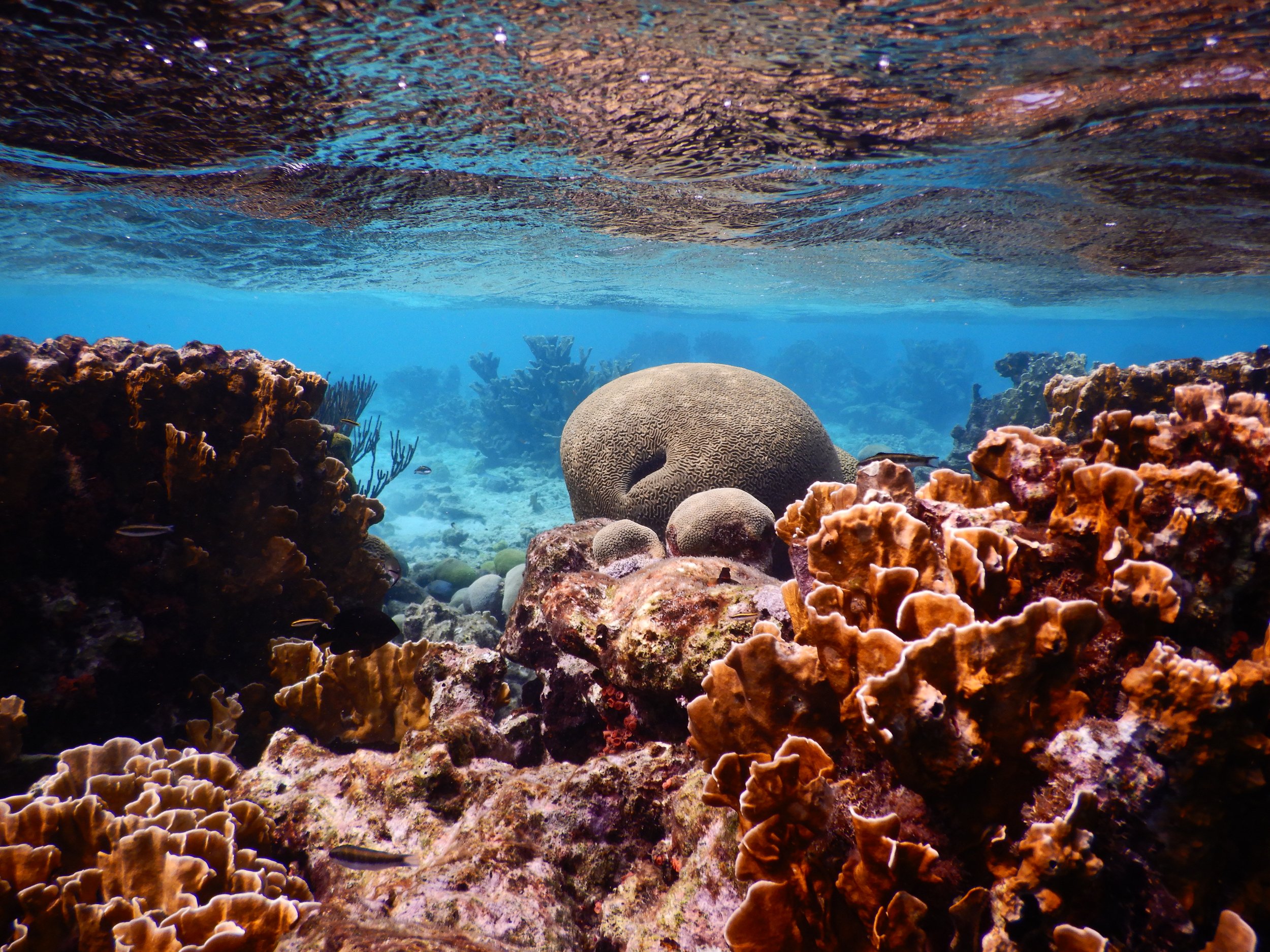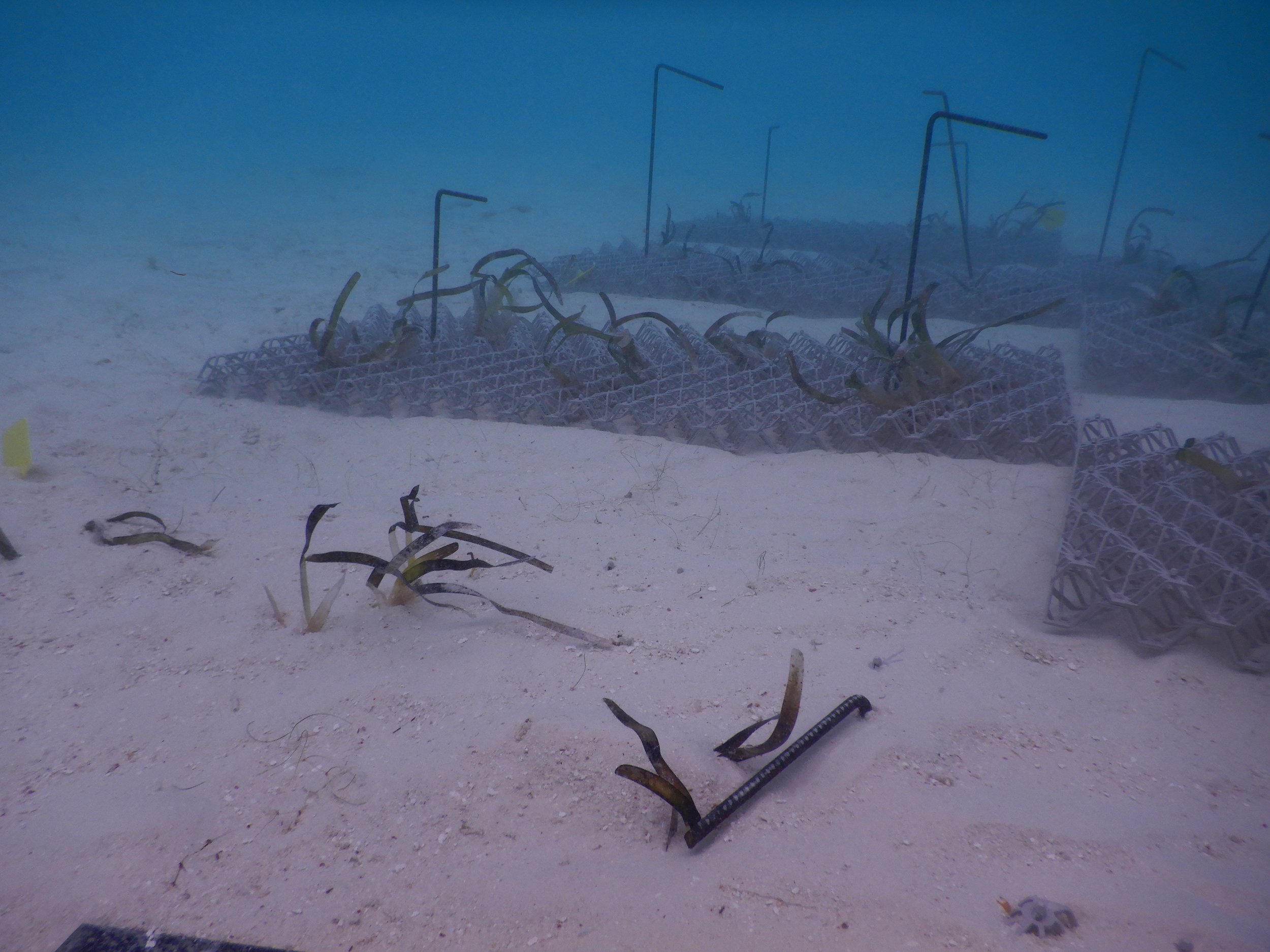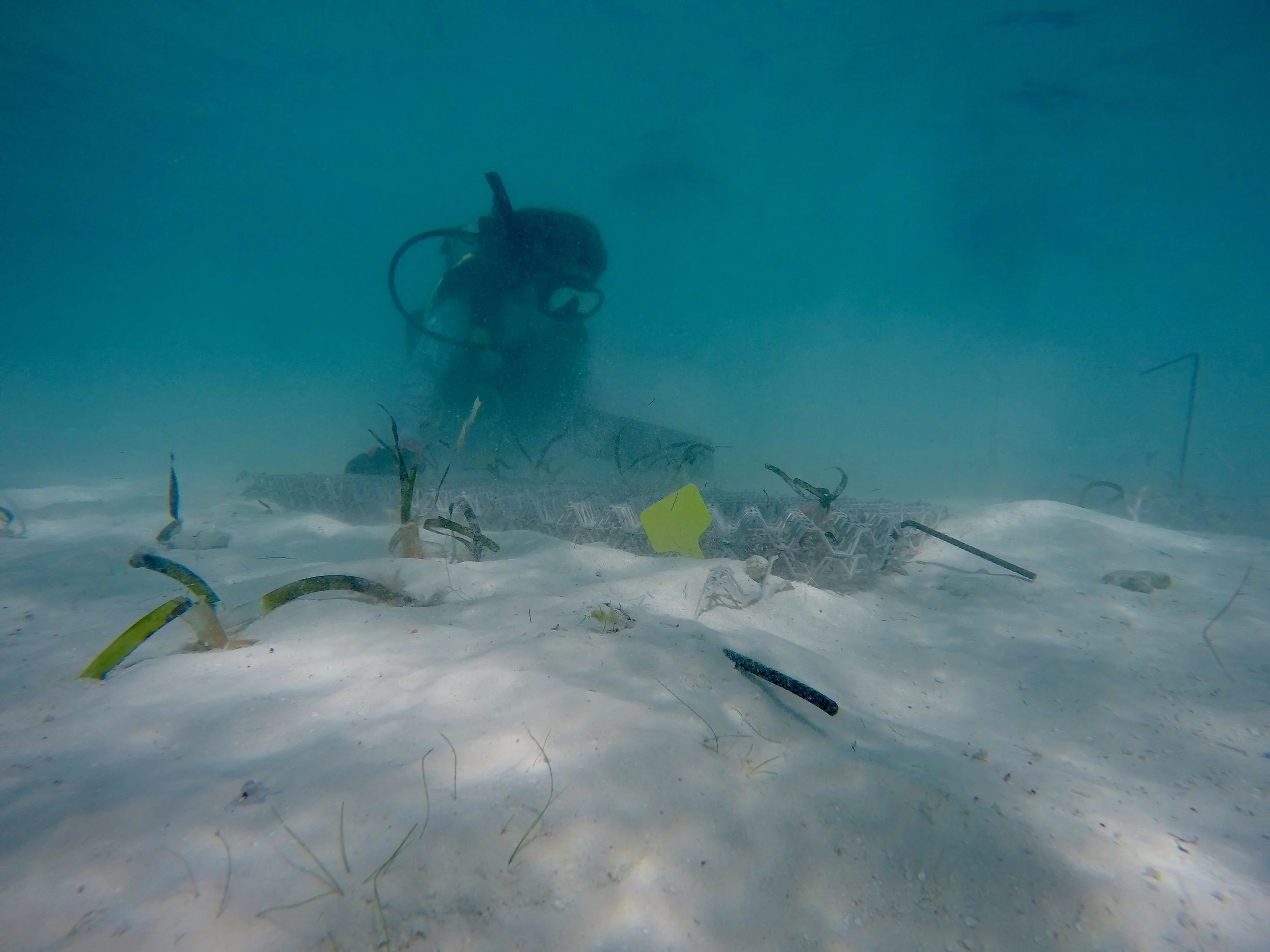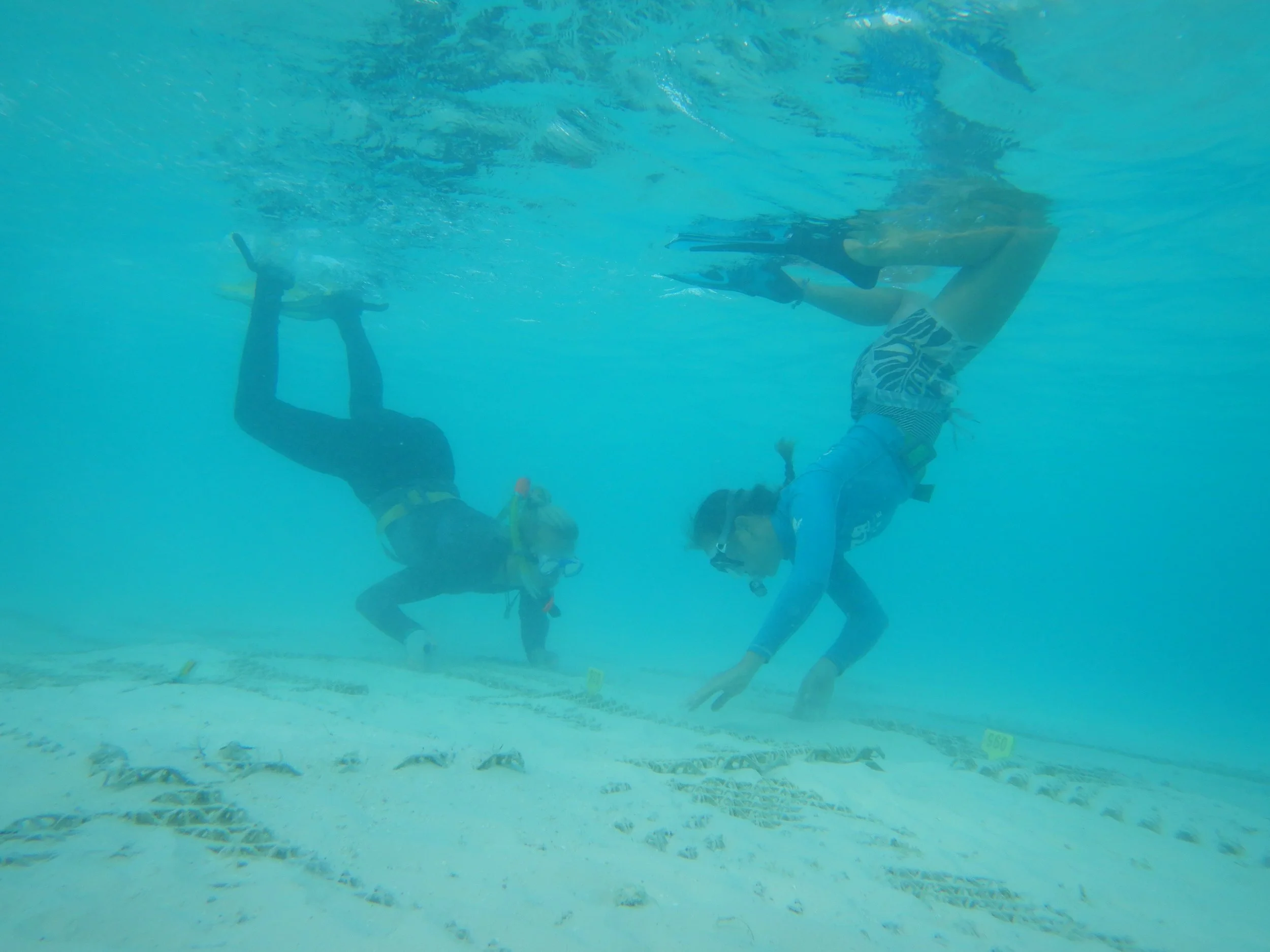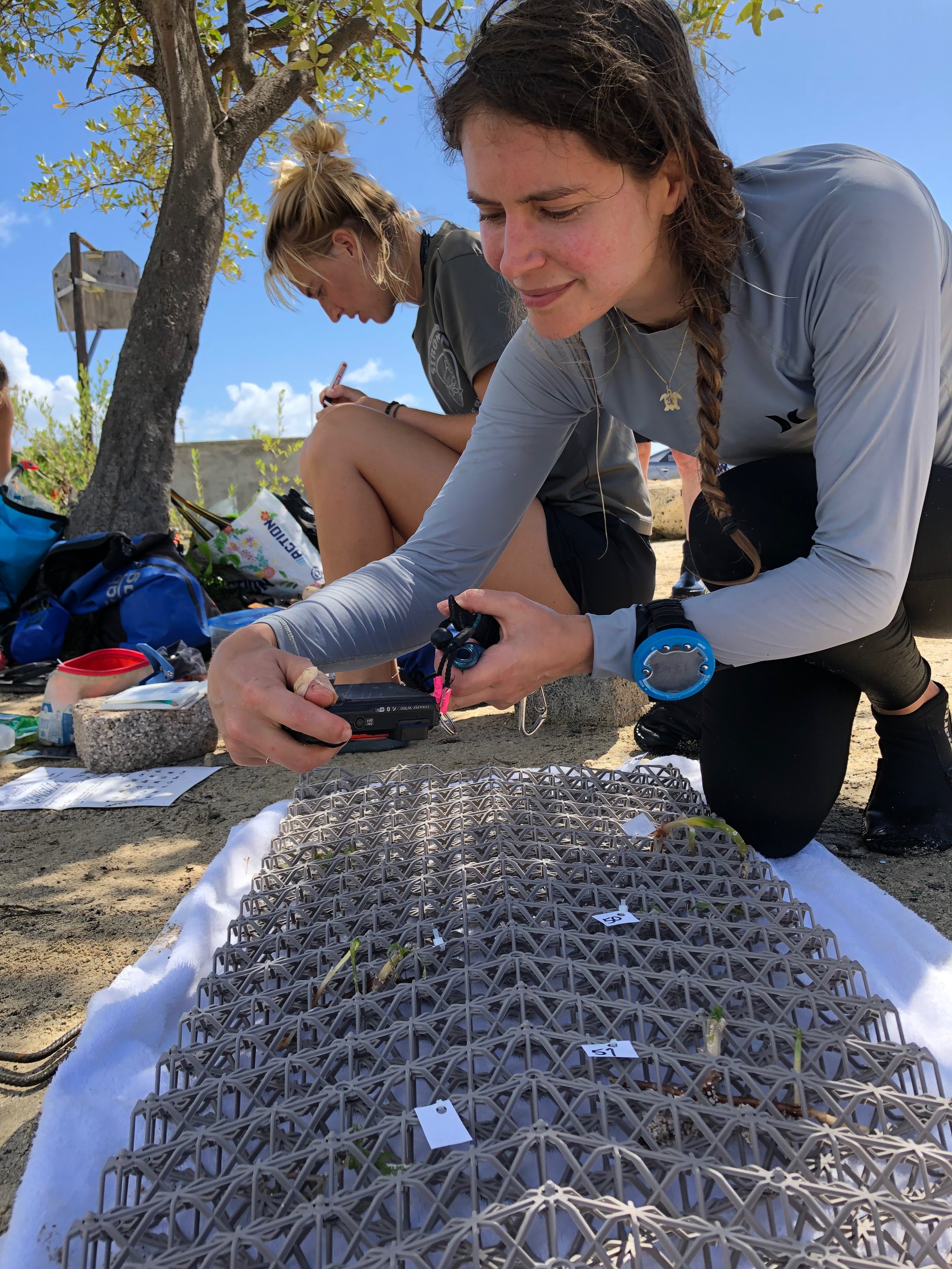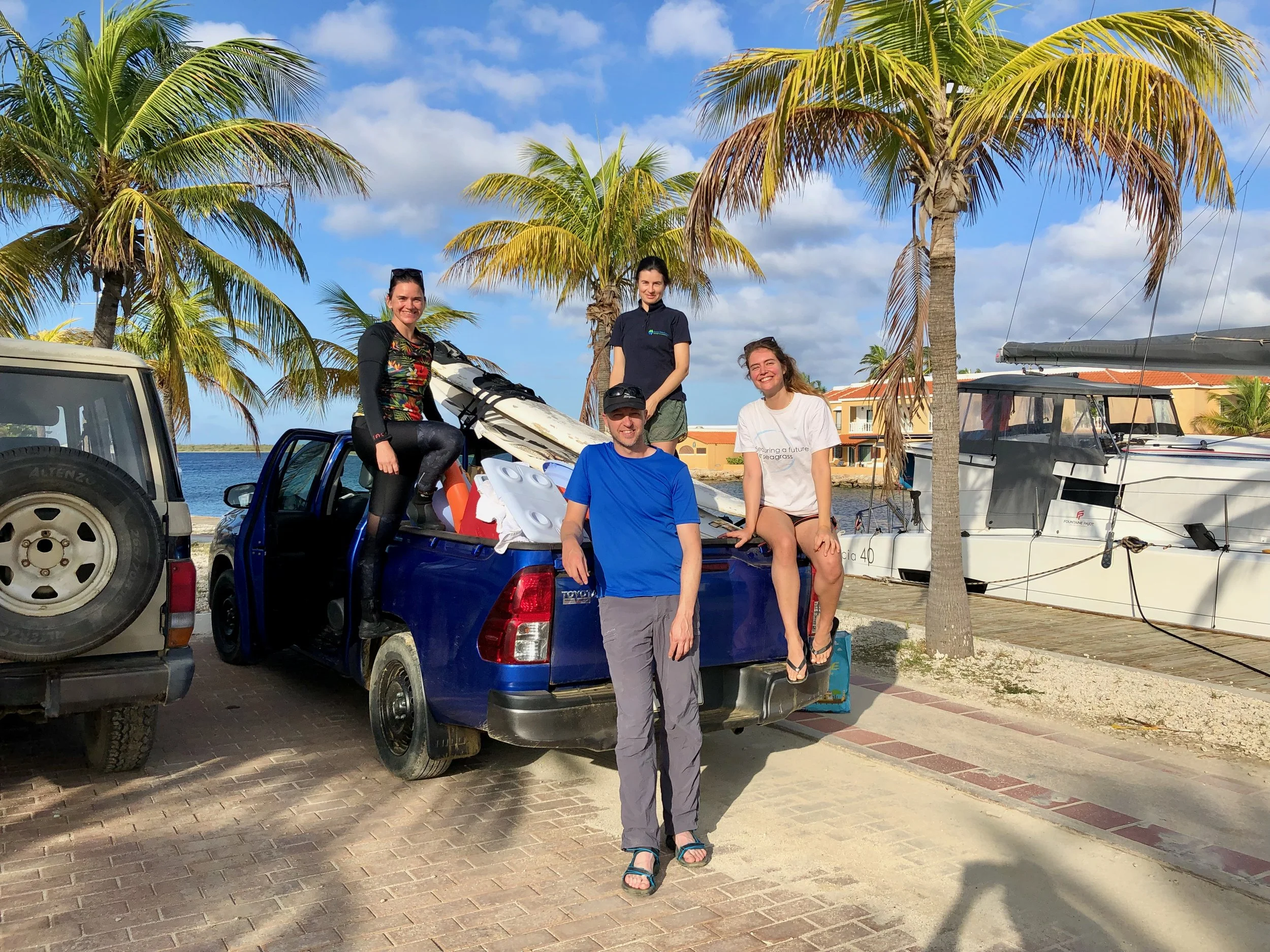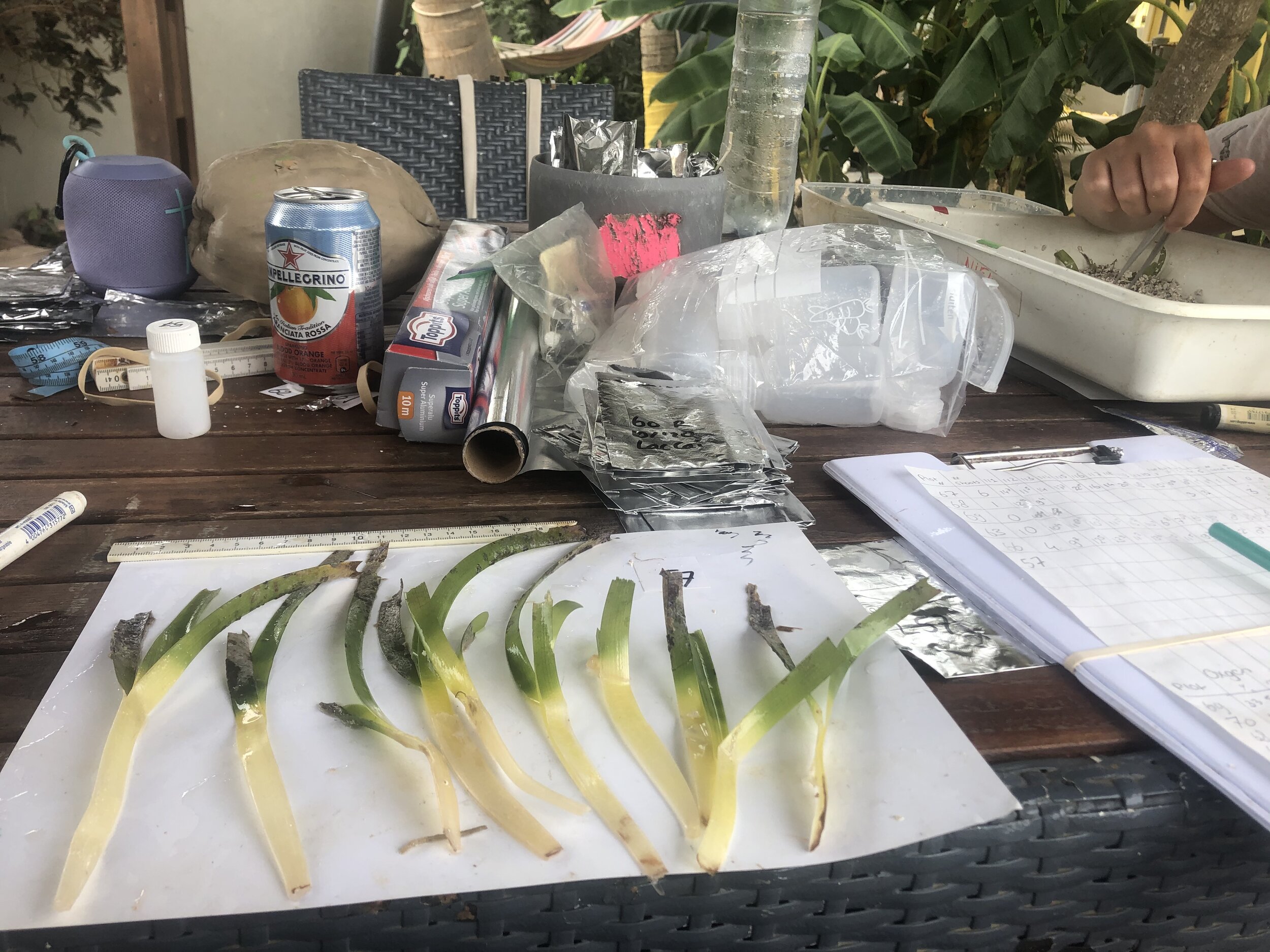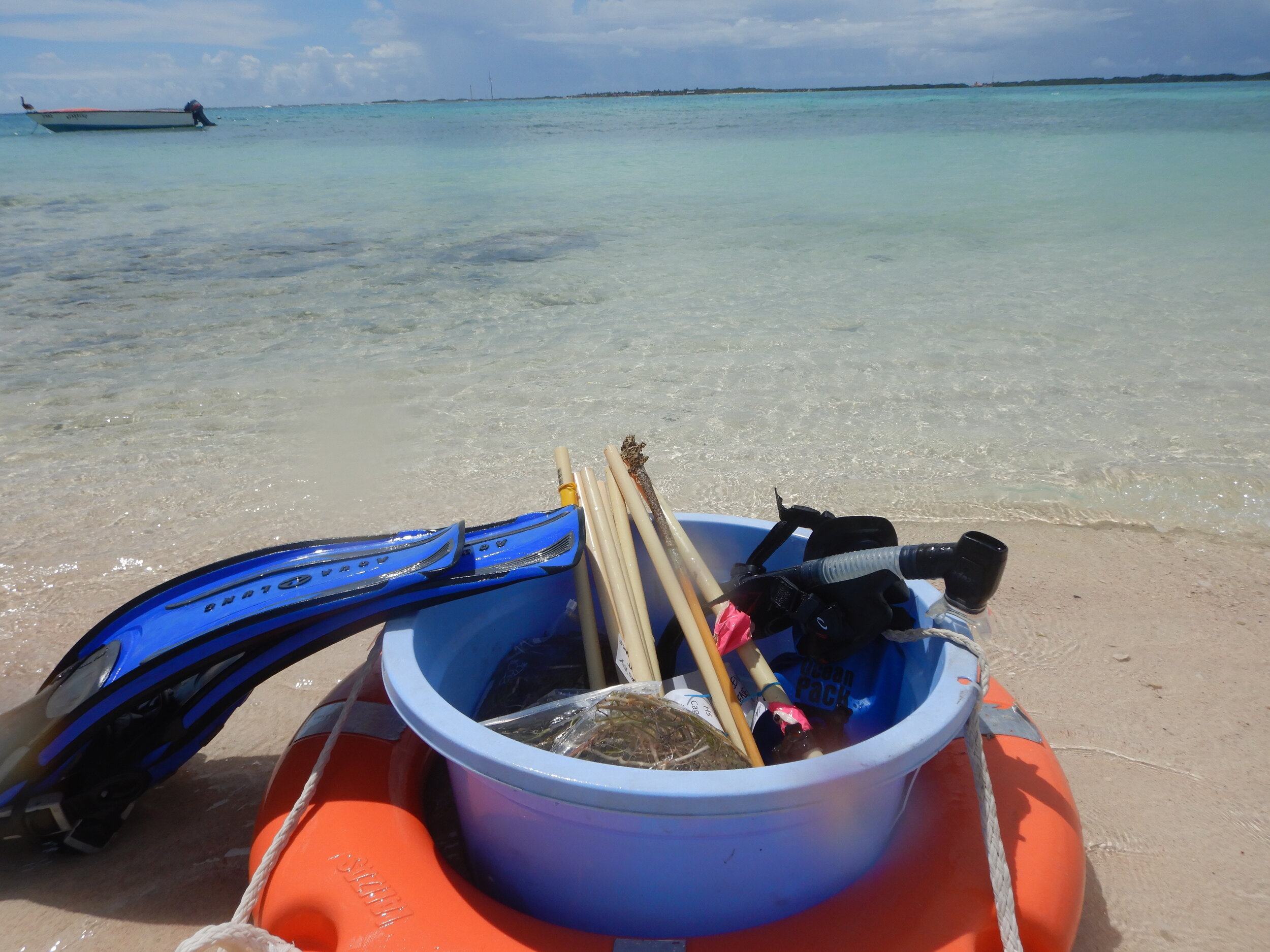
New paper out in Global Change Biology: Sea turtles are returning, what are the effects on ecosystem functioning?
Sea turtles have been overharvested in the past, resulting in their endangered population status. But since two decades, their populations have recovered in certain areas around the world, and their ecological role is unfolding. The seagrass meadows they feed on are returning to their naturally grazed state as a result. Some are even becoming overgrazed. How does the return of the sea turtle affect the functioning of coastal ecosystems?
A research team analysed the seagrass ecosystem value (such as coastal protection and carbon storage) along a turtle grazing area from low to high. In experiments, they determined the impact of recovering sea turtle populations on ecosystem functioning. The team, led by Wageningen University, with colleagues from the Netherlands and the Dutch Caribbean, recently published their findings in Global Change Biology.
Seagrass meadows provide us with a range of goods and services. For example, they provide a habitat and food for many commercially important fish species. They also help protect the coast by stabilising sediment, and reducing wave energy. With the return of the large herbivore – the sea turtle – it is important to quantify their impact on the ecosystem services a seagrass meadow can provide. Often these services are measured separately, but in the new study, the most essential services have been assessed together to assess the ecosystem’s multifunctionality.
Combining ecosystem services in one index
“Our approach to measuring different ecosystem functions simultaneously and combining these in one ecosystem-multifunctionality-index is new for marine habitats and led to striking results,” says Marjolijn Christianen, lead investigator of the study. “We found that medium turtle grazing pressure increased carbon storage and nutrient cycling in seagrass meadows. On the other hand, fish biomass and other services were higher in meadows without turtle grazing. More importantly, we found a simultaneous collapse of all these services under severe turtle grazing pressure.”
Figure 1: Three scenarios of megaherbivore grazing intensity can be observed in tropical seagrass ecosystems with green turtles as megaherbivores worldwide (Fig a). The turtle’s ecological role is rapidly unfolding in numerous foraging areas where populations are recovering through conservation after centuries of decline, with an increase in recorded overgrazing episodes. In field experiments, researchers assessed the effects of simulated grazing intensity scenarios on ecosystem functions and multifunctionality (Fig b) in a tropical Caribbean seagrass ecosystem over an 18-month period.
Integrative approach for balanced ecosystems
Based on these results, the authors argue that the successful return of the sea turtle should be accompanied by the protection of their habitat, seagrass meadows, as well as their predators, who can influence turtle grazing behaviour through fear effects. “Based on recent insights from studies in the Bahamas, the resulting spatial variation in grazing pressure can probably prevent habitat collapse,” says Fee Smulders, co-author of the study. Christianen: “By taking an integrative ecosystem approach to management, we can maintain high ecosystem multifunctionality, as well as balanced ecosystems that can sustain natural densities of charismatic sea turtles”.
Pristine seagrass meadows
Green sea turtles are considered the megaherbivores of the ocean. Since their populations have been decimated, scientists have become accustomed to studying and experiencing ungrazed seagrass meadows. These lush seagrass meadows dominated by sturdy species are considered healthy, in ‘pristine’ condition, and very valuable. But with the return of the green sea turtle in many coastal areas in the past decades – due to successful conservation – many seagrass meadows have been transformed into grazed seascapes.
An earlier paper published in Nature, Ecology and Evolution by Wageningen researchers discussed how we must reconsider our view of a pristine seagrass meadow, which likely consists of a mosaic of (heavily) grazed patches and ungrazed patches with high plant species diversity and higher biodiversity in general. This mosaic seascape may be more natural, even though the ecosystem value may be slightly lower than ungrazed meadows. Now that the different grazing scenarios (high turtle abundance, low abundance, sometimes hyper-abundant) coincide in all three ocean basins where turtles are found, the outcomes of these new studies are even more globally relevant and urgent. The findings can also be used to predict ecosystem impacts of future shifts.
Interview in Dutch newspaper
After the International Seagrass Biology Workshop I was motivated to step up my game to spread the word about the importance of seagrass meadows to the general public. I emailed a big national newspaper with information why seagrass deserves some more attention, and received a reply that they wanted to interview me. The result is a super nicely written piece about my PhD work, see below!
Conference season!
After 2.5 years of cancelled conferences, we are finally able to meet in person again. As a PhD student, conferences are super valuable to be able to meet and discuss ideas with more established researchers in your field, to present some of your own work and to meet fellow PhDs and share your struggles.
This august, I travelled to Annapolis, Maryland to attend the International Seagrass Biology Workshop. 5 days of seagrass science with 200+ people! The seagrass community is incredibly open, supportive and optimistic which made this week into a huge success. There were talks about restoration success stories from Denmark, Indonesia to Australia, and once again it was emphasized how important it is to create & spread awareness to the public on the value of seagrass ecosystems, as it is still the least protected marine habitat. I presented an overview of 3 of my PhD projects and won the 2nd prize for best student talk! Additionally, I attended a 2-day workshop where we started working on a review to compile all knowledge on novel species in seagrass ecosystems. I arrived back home full of inspiration and motivation to continue in this line of research.
Then this September it was time for the Netherlands Annual Ecology Meeting. During this meeting, all ecologists working in institutes in the Netherlands gather to connect and share their knowledge. We had great plenary talks from among others Grant Hopcraft on wildebeest in the Serengeti, Judy Shamoun-Baranes on bird migration and Laura Govers on coastal ecosystem restoration. I presented in the Coastal ecology sessions among my fellow-PhDs who are all doing great work in coastal ecosystems in the Netherlands and abroad. Once again a great conference (at a beautiful green venue) and hope to see everyone at the next edition.
Article in KIJK magazine (Dutch)
Last year in November, journalist Merijn van Nuland joined my fieldwork on Bonaire. It was great to be able to take a journalist with me into the field and snorkel through the beautiful seagrass meadows together. This resulted in a very nice article in Kijk magazine, about seagrass, turtle and shark interactions. See below!
Fieldtrip Bonaire: Seagrass and mangrove restoration
Near the end of 2021, we organized a fieldtrip to Bonaire with a focus on seagrass and mangrove restoration. Together with STINAPA and BESE-products funding was obtained to restore a large patch of seagrass, and set up some smaller scale restoration experiments, making use of ‘BESE elements’: biodegradable 3D mats mimicking complex root structure. The BESE elements can be used to reduce hydrodynamic stress and therefore help ecosystem engineers as seagrasses, mangroves and oysters overcome the first barrier on their way to successful settlement and expansion.
As part of our team 2 students joined who will work on this project for their Msc thesis at Wageningen University. We worked hard for one week trying out different methods and visiting various sites for our experiments: we needed sites with substantial amount of wave action, but otherwise suitable environmental conditions for our target species to grow. For the seagrass, we chose a logistically hard to reach but otherwise perfect site for our large-scale restoration, and chose a checkerboard fashion to deploy the BESE elements. We spend several days planning logistics and then a whole day digging the sheets (with seagrass fragments) in the sediment by hand, and managed to finish a large plot, spending 8hrs non-stop underwater.
After one week, I stayed on with just the students and our local collaborators to finalize the mangrove and seagrass experiments. For the mangroves, a site along the south west shore was chosen: this region lies relatively low compared to the sea level, and could definitely use some sediment accreting mangroves protecting the shoreline. Another seagrass experiment was set up looking into differences of native and invasive seagrass restoration in Lac Bay.
This was a great two week fieldtrip with a super motivated and full-of-energy team, and I’m super excited to discover what the students will find out during their fieldperiod. Updates will follow! See below for an impression of our time on the island.
New paper out! Herbivore fish can play key role in slowing down invasive seagrass
An invasive species of seagrass is rapidly expanding in the Caribbean. This species is suppressing native seagrasses, reducing coastal protection and decreasing biodiversity. It would be good if the ecosystem itself could offer resistance to this exotic species. For example, through native herbivores, with a taste for the species which could prevent proliferation.
In a new study researchers from Wageningen University & Research, together with colleagues from Amsterdam and Miami, have discovered that fish can take on this role.
PhD candidate Fee Smulders and Dr. Marjolijn Christianen saw that, in Lac Bay on Bonaire, hardly any invasive seagrass grew in places with plentiful fish. In several pilot experiments, it even disappeared entirely at times. The researchers suspected that fish were playing a role in this. In order to test this, they set up an underwater experiment that included cage treatments, which excluded most of the fish. This allowed them to measure the effect of the fish on the invasive seagrass.
“A protected area with lots of native grazers can be more resistant to invasive species”
Lac Bay is part of a marine protected area. To complete the comparison, MSc student Tatiana Becker conducted the same experiments on Aruba. But in an unprotected seagrass ecosystem with fewer grazing fish, and lower species diversity.
Resistance to invasive species
“Our results show that grazing fish can reduce the expansion rates of invasive seagrass by half,” says Fee Smulders. “This effect is reinforced by local nutrient enrichment, because fish love to eat leaves rich in nutrients. Native seagrass species are better adapted to high grazing pressure, while invasive seagrass disappears under high pressure. But this mechanism only applies in the protected ecosystem of Bonaire, where fish densities are quite high. On Aruba, we saw no difference after nutrient addition. Invasive seagrass also grew much faster there, probably due to low fish densities. So a protected area with lots of native grazers can be more resistant to invasive species.”
Green sea turtles and seagrass
This research is an additional piece of the puzzle to better understand invaded ecosystems. Earlier, the researchers discovered that green sea turtles hardly ever eat the invasive species, which encourages expansion of the invasive species. Because the invasive species only reproduces clonally, and not by flowering and seed formation, this protective role of fish is very important. Now that the team knows that fish do include the seagrass in their diet, they can better understand patterns and dynamics in the ecosystem.
Marjolijn Christianen: “In the past it was thought that herbivores hardly play a role in seagrass dynamics. Now we know better, and show that they are indispensable and can shape the underwater landscape. Our results add to the growing evidence that protection of marine areas is effective, and urgently needed.”
Funding from Stichting Lucie Burgers for new customized cameratags
Last year, I got the news that our proposal for the Stichting Lucie Burgers was granted, and that we could go ahead with purchasing high tech cameratags for follow-up studies.
Stichting Lucie Burgers yearly awards research projects in the field of behaviorial ecology. In our new study, we would like to investigate how green turtles impact their seagrass habitat, and how trophic interactions impact their spatial grazing strategy. In previous studies using our own assembled cameratags, we could film for 5 hrs straight, and measure temperature and depth.
With our new cameras from CATScam, we will be able to film for ± 8 hs, and additionally get information on the GPS trajectory of the animals, swimming speed, and more. More importantly, we can program the tags with a delayed start. This way, we can start filming in the morning and don’t include potential stress effects of capturing and handling the animals. The cameras arrived last week, see picture below.
Due to COVID19 related delays, we plan to use the tags in Mexico in 2022. Which gives me some time to play around with them, make sure I know how they work, and try them out. Updates will follow!
Our work featured in The New York Times!
Our study on how tourists feeding turtles could be harmful was featured in an article on The New York Times, and even made the cover of the international edition. Great honor to be mentioned by this paper, and very important that the message on harmful impacts of feeding marine wildlife is spread as far as possible. Great collaboration together with nature photographer Shane Gross to get this story out.
Cover of the international weekend edition of The New York Times, 15-16 May, 2021
Screenshot of New York Times article, published May 11, 2021, written by Priyanka Runwal
Caught on film! TurtleCams show how tourists feed (and influence) turtles
Young green turtles’ behaviour is influenced by tourists feeding the animals. This was discovered by researchers of Wageningen University & Research through the use of TurtleCams: cameras mounted on the shells of green turtles in the Bahamas. This is the first time scientists use such cameras to record the interaction between tourists and animals for scientific purposes.
The green turtle is an endangered species whose population has plummeted. The animals must continuously adapt to – amongst other – habitat loss and climate change. The increasing influence of tourists pose an extra threat to the species, Fee Smulders, PhD candidate Aquatic Ecology and Water Quality Management, discovered.
New camera system
Wageningen researchers developed a new, low-cost GPS-camera system in collaboration with co-author Owen O’Shea of the Centre for Ocean Research and Education in the Bahama’s. This system allowed them to film the behaviour of five green turtles for five hours. After five hours, the adhesive with which the camera was attached dissolved, allowing the device to float to the surface. Following the GPS signal, the researchers then retrieved the cameras.
The recorded images revealed not only how the five turtles that were equipped with a camera behaved, but also showed footage of other green turtles without cameras. The footage is available online through the link of the open-access paper. Smulders: ‘Using cameras in this way allows us to narrate the wild animals’ own story, about their natural behaviour and their interaction with humans.’
New food source
Green turtles in their natural habitat are mostly vegetarians. Seagrass is their staple food. The TurtleCam footage, however, showed tourists feeding the animals bits of squid. The researchers calculated that the turtles’ seagrass consumption was reduced six-fold when tourists were in the area. In the long run, their body will evolve to accommodate such new food sources, making them dependent on fish and meat, which are not always available. This poses an additional challenge for the already endangered animals.
Aggressive
In addition to changes in their diet, the scientists also noted a change in behaviour. These naturally calm animals exhibited aggressive behaviour towards each other, in competition over food, and towards the tourists. ‘They probably confused hands and fingers with food’, Smulders thinks. The competition for food and related aggression worsened when the corona pandemic caused a sudden drop in tourism in 2020.
The TurtleCams revealed that green turtles purposely swim towards boats and humans. ‘Normally, we use special nets to catch the turtles for research purposes. Here, we could simply scoop them out of the water with our hands,’ says Smulders. ‘The animals being this tame is a threat.’ It increases the risk of injury through, for example, boat propellors, and makes them vulnerable to poachers. Although poaching is strictly prohibited, poachers still operate all over the world. ‘Sadly, we discovered our prediction was correct: a poacher recently extracted eight green sea turtles from the waters at our research location,’ Smulders states.
Global issue
Following an online search, the team discovered that tourists across the globe feed sea turtles. Not just the green sea turtle, but also two other (critically) endangered turtles, the loggerhead turtle and the hawkbill sea turtle. ‘This leads us to believe that the change in diet and behaviour of the sea turtles occurs in all their habitats, from Australia to Tenerife’, says Marjolijn Christianen, assistant professor at Wageningen University & Research.
‘Our research shows the dangers of feeding wild sea animals’, Christianen states. ‘To mitigate the damage and protect the turtles, we must communicate the consequences of this feeding activity to tourists around the world.’ The researchers published their findings in the scientific journal Global Ecology and Conservation.
Fieldtrip to Bonaire in COVID19 times
During 2020 a lot of our fieldtrips were cancelled due to travel restrictions. Therefore we had to quickly find alternatives and work together with local researchers that could maintain our ongoing experiments, for example on Bonaire. But after one year, our turtle exclosure experiment would come to an end and an intensive set of final measurements and sampling could not be arranged from a distance. After applying for special permission I finally was allowed to travel to Bonaire in October 2020, although my students were not allowed to travel with me.
An empty plane, an empty island! It was a different experience on Bonaire, with dive shops closed, and predominantly residents on the island. The vibrant dive community is what livens up the island and although tourists form the main income for the island, I did not miss the 3000+ tourists that arrive at the island everyday by cruiseboats.
I worked together with one student that managed to travel to Bonaire when it was still allowed, and together we performed all final measurements of the turtle exclosure experiment, took underwater videos, processed a lot of samples into the evenings and in our limited spare time went for some fun dives!
The trip was very successful, I was amazed at the impact of excluding turtles for one year on the seagrass morphology. Measurements will reveal the impact of turtle grazing on ecosystem services and recovery capacity of turtlegrass. See below an impression of our time on Bonaire





